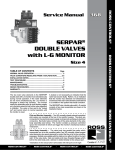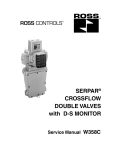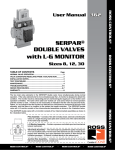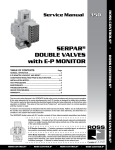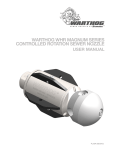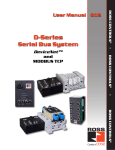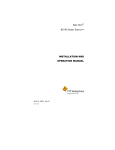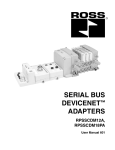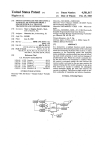Download ROSS CONTROLS® SERPAR CROSSFLOW DOUBLE VALVES
Transcript
ROSS CONTROLS® ® SERPAR CROSSFLOW DOUBLE VALVES with L-G MONITOR Size 4 Service Manual 368A TABLE OF CONTENTS Page INTRODUCTION........................................................................................... 2 NORMAL VALVE OPERATION . ................................................................... 3 VALVE CONDITIONS RESULTING FROM A MALFUNCTION.................... 4-5 INSTALLATION NOTES................................................................................. 6 TEST PROCEDURE........................................................................................ 6 MAINTENANCE............................................................................................... 7 TROUBLESHOOTING.................................................................................. 7-8 REPAIR PROCEDURES............................................................................. 8-11 WARRANTY................................................................................................... 12 INTRODUCTION The two main valve elements in the SERPAR® Crossflow double valve with L-G monitor move simultaneously during normal operation. If the valve elements do not move simultaneously, the L-G monitor is designed to detect this condition. The monitor reacts by exhausting pilot air and blocking supply air to the pilot valves so that further valve operation is inhibited. The valve is then said to be “locked out” and cannot return to normal operation until the monitor is reset. A lockout is not necessarily an indication that the valve has become faulty. Rather, it is an indication that the monitor has detected non-simultaneous movement of the main valve elements and that there is a condition in the system that needs correction. The SERPAR® Crossflow size 4 double valve with L-G monitor consists of two main assemblies as shown in the illustration below. Pilot and Monitor Assembly – Two 3/2 normally closed solenoid controlled pilot valves are mounted at the top of the monitor housing. The pilots are connected to the electrical power supply via dropcords and plug-in electrical connectors. Each pilot valve controls one of the valve elements in the valve body assembly (see below). The monitor contains a pressure controlled spool, the movement of which can trigger the monitor’s mechanical lockout mechanism. Valve Body Assembly – The valve body has parallel flow paths which incorporate two in-to-out crossflow paths, two 3/2 normally closed poppet valve elements, plus spool elements to control the flow of air in the crossflow passages. Models are available with the inlet port on either the left or the right side* of the valve body. Inlet and outlet ports have threaded flanges which bolt to the valve body, and a silencer is bolted directly to the exhaust port. *Illustrations in this manual show valve bodies with inlet ports on the right. ROSS CONTROLS® NORMAL VALVE OPERATION F Becoming thoroughly familiar with the functions of the SERPAR® Crossflow double valve and its L-G monitor will help in analyzing lockouts and finding their causes. The next few pages should be studied carefully to get an understanding of both the normal valve functioning and what happens when a malfunction occurs. F C M M CONDITIONS AT START Inlet air is blocked from the outlet port by two normally closed valve elements A and B (see Figure 1). The outlet port 2 is connected to the exhaust port 3. Pilot supply air is carried via passage 4 around monitor spool C, and up to the two normally closed pilot valves F. Spool C is the sensing element of the L-G monitor and is kept in its center position by springs M. Refer also to the schematic diagram of pilot air flow given in Figure 5. 4 A B 1 SOLENOIDS ENERGIZED Figure 1 — Solenoids Not Energized Simultaneously energizing the two solenoids “a” and “b” (see Figure 2) causes the two pilot poppets E to shift upward. This closes the pilot exhaust passages 7 and opens the pilot supply passages. Pilot air can then go from the supply passage 4 to the main valve piston poppets J via passages 9. Pressure on the piston poppets shifts the main valve elements. This closes off the exhaust port 3 and connects inlet port 1 to outlet port 2 via crossflow passages 10 and 11. With the main valve inlet poppets U and V open, the monitoring passages 6 are open to inlet pressure which is directed to both ends of the monitor spool C. Because these monitoring pressure signals are equal, spool C remains in its center position. SOLENOIDS DE-ENERGIZED 7 b E C 7 a E 9 9 J J 4 6 Simultaneously de-energizing solenoids “a” and “b” allows the two pilot poppets E to return to their normally closed positions (Figure 1). Pilot pressure on the main valve pistons J is exhausted through the pilot exhaust passages 7. The main valve elements A and B return to their normal deactuated positions. Inlet air is again blocked by poppets U and V. Pressure at outlet port 2, at the ends of spool C, and in the monitoring passages 6 is exhausted through port 3. This completes the normal operating cycle, and the valve has returned to the CONDITIONS AT START described above. 6 1 11 V 10 U Figure 2 — Solenoids Energized www.rosscontrols.com VALVE CONDITIONS RESULTING FROM A MALFUNCTION Inlet Pressure Passages C YB YA M M Lockout Signal Passage L-G Spool J 4 B 6 A 1 SB 10 Manual Reset Valve Lockout Mechanism U Figure 3 — Valve in Faulted Condition Passage 4 From L-G Reset Spool to Interlock Pilots Spool Figure 4 — Horizontal Cross Section of L-G Monitor DURING A MALFUNCTION If conditions do not allow one of the main valve elements to be shifted, or do not allow one of the elements to return to its normally closed position upon deactuation, we have the condition depicted in Figure 3 — one valve element closed and one open. Inlet air flowing past open poppet U and into crossflow passage 10 is practically blocked by spool SB on valve element B. Although some air can pass around spool SB, the amount is so small, and the exhausting capacity of the valve so large, that the pressure at outlet 2 does not exceed two percent of inlet pressure. At the same time, a monitoring air signal goes via passage 6 to the right end of spool C, but no signal goes to the left end. When the difference in pressure at the ends of the spool exceeds 1.5 bar (20 psi) the spool is shifted. In this case the spool is shifted to the left as shown in Figure 5. The spring-loaded lockout pin K drops into lockout groove 8 so that the spool is held in its shifted position. Pilot supply air in passage 4 is then diverted around the spool and out to atmosphere via bleed vent YA. Simultaneously, air in the pilot supply passage 9 is vented to atmosphere via bleed vent YB. (Vents YA and YB are located on the back of the monitor housing as shown in Figure 9.) This exhausting of pilot air removes pressure from piston J making it possible for valve element A to return to its deactuated position. Note that these same conditions occur if valve element B is the open valve element and the L-G spool is shifted to the right. See Figure 5. The venting of pilot supply air through vent YA prevents further valve actuation, and the valve is “locked out.” Normal valve operation cannot be restored until the cause of the malfunction is corrected and the L-G monitor is reset. YA 8 9 YB Spool Shifted Left 4 K 8 YA 9 YB Spool Shifted Right ROSS CONTROLS® 4 K Figure 5 — Lockout Positions of L-G Spool VALVE CONDITIONS RESULTING FROM A MALFUNCTION Pilot b Pilot a Pilot b Reset Interlock Reset L-G Spool Centered L-G Spool Lockout Pin Retracted Manual Reset Valve Pilot a Interlock YB YA Lockout Pin Engaged Lockout Mechanism Pilot Supply From Inlet Port Manual Reset Valve Lockout Mechanism Pilot Supply From Inlet Port Figure 6 — Normal Pilot Air Flow Figure 7 — Pilot Air Flow During Lockout Normal Operation. Pilot air supply from the inlet port of the double valve flows around the L-G spool, past the reset interlock spool, and on to the pilots. When the pilot solenoids are energized, pilot air goes to the pistons of the main valve elements. During Lockout. The L-G spool is shifted off center. The springloaded lockout pin engages a slot in the spool to keep it in the shifted position. Pilot supply air is then diverted to atmosphere via vent YA. Air remaining in the pilot lines is exhausted to atmosphere via vent YB. RESETTING THE L-G MONITOR After the cause of a lockout has been corrected, the spool in the L-G monitor must be reset to its normal center position in order for the valve to function properly. To ensure that the equipment controlled by the valve does not begin operating immediately after resetting the monitor, electrical power to the valve solenoids must be off before resetting. Otherwise, the energized solenoids will actuate the valve as soon as the reset pressure signal is removed. The resetting action is accomplished by applying air pressure of at least 2 bar (30 psig) to the lockout mechanism. This is done in one of two ways, depending on the particular valve model. Manual reset models have a reset valve which directs inlet air to the reset mechanism. Remote reset models use an external pressure source and an external reset valve to apply the pressure via a threaded reset port in the monitor body. Regardless of the type of reset, applying the reset pressure produces two results: (1) lockout pin K (see Figure 5) is lifted out of the lockout groove so that the centering springs M can return the spool to its center position; and (2) the reset interlock spool (see Figures 4 and 8) is shifted so that the pilot air supply passage is blocked and remains blocked during the resetting process. In this way the valve is kept inoperative while resetting air pressure is applied and any attempt to circumvent the function of the L-G monitor is hindered. However, to ensure that the equipment controlled by the valve does not begin operating immediately after resetting the monitor, electrical power to the valve solenoids must be off. Otherwise, the energized solenoids would actuate the valve as soon as the reset pressure signal is removed. Pilot b Pilot a Reset Interlock L-G Spool Centered Lockout Pin Retracted Manual Reset Valve Lockout Mechanism Pilot Supply From Inlet Port Figure 8 — Pilot Air Flow During Reset During Reset. When the manual reset valve is actuated pilot supply air goes to the lockout mechanism so the lockout pin is retracted. The L-G spool then recenters itself. At the same time, air flow to the reset interlock moves the interlock spool so that air to the pilots is cut off and remains so as long as the reset valve is actuated. On remote reset models the manual reset valve is replaced by a threaded reset port, and air flow to the reset interlock moves the spool so that air to the pilots is cut off and remains so as long as remote reset air is applied. www.rosscontrols.com INSTALLATION Pneumatic equipment should be installed only by persons trained and experienced in the installation of such equipment. Air Lines. Before installing a double valve in an existing system, the air lines must be blown clean of all contaminants. One of the leading causes of lockouts is foreign material from the air lines which becomes lodged in the valve. It is strongly recommended that an air filter be installed ahead of and close to the valve and that the filter be properly maintained. Valve Inlet 1. (See Figure 9.) DO NOT RESTRICT THE AIR SUPPLY. Any restriction of the supply lines (sharp bends, undersize lines, etc.) reduces the speed at which the outlet volume is pressurized. See Inadequate Air Supply on page 8. Valve Outlet 2. For faster pressurizing and exhausting of the outlet volume, locate the valve as close as possible to the mechanism being operated. Also, any restriction in the outlet lines will reduce both pressurizing and exhausting speeds. Valve Exhaust 3. DO NOT RESTRICT EXHAUST. Limiting the exhausting speed decreases an important safety feature of the double valve. During a malfunction in which only one of the valve elements is shifted, air escaping past the spool in the valve stem of the closed valve element (see Figure 3) must be quickly exhausted to keep outlet pressure at or below the design pressure of two percent of inlet pressure. See Undersize or Plugged Silencer, page 11. Remote Reset Port N. Remote reset models require a minimum supply pressure of 2 bar (30 psig). Use a 3/2 reset valve. Lockout Signal Port S. Can be connected to a normally closed pressure switch to operate a lockout indicator light. Loss of pressure signifies a lockout. Electrical Connections. The solenoid lugs can be faced forward, to the sides, or to the rear by loosening the knurled nuts on the tops of the solenoids and rotating the lugs to the desired position. The electrical supply must be of the correct voltage and frequency. The solenoids are rated for continuous duty at 85% to 110% of the voltage marked on the solenoid. A supply voltage that does not fall within this range can cause nuisance lockouts or premature solenoid burnouts. If electrical power is supplied through a transformer, it should be capable of handling the inrush current of the solenoids without significant voltage drop. Mounting Position. It is recommended that valves be mounted with the solenoids on top wherever possible. Pressure Range. Inlet pressure should fall in the range of 2 to 7 bar (30 to 100 psig). Pressure below this range may render the L-G monitor inoperative or lead to intermittent lockouts. Pressure above this range can nullify the monitor lockout function, and also causes excessive poppet impact which shortens the life of the valve. Temperature Range. Ambient temperature should be in the range of 4°C to 50°C (40°F to 120°F). Temperature of the operating media should be in the range of 4°C to 80°C (40°F to 175°F). Improper valve action and/or shortening of valve life can result if these temperature limits are not observed. TEST PROCEDURE Valves are tested after assembly to assure proper operation, but it is recommended that the following tests be made when the valve is initially installed, or whenever the valve has been disassembled . These tests should be made both at the repair bench and at the installation. At the installation, take normal press operation safety precautions during these tests to avoid the potential for human injury or damage to equipment. are two bleed vents, YA and YB (see Figure 9). Bleed vent YA should emit a continuous flow of air. De-energize the other solenoid (“b”). All tests should be performed only by persons trained and experienced in the testing of pneumatic equipment. 6. Reset the monitor by pressing the reset button, or if the valve is a remote reset model apply pressure of at least 2 bar (30 psig) to reset port N. Air flow from bleed vent YA should stop. Remove reset pressure. If the valve fails any of the following tests, refer to Troubleshooting beginning on page 7. 1. Remove silencer. 2. Apply compressed air in the 2 to 7 bar (30 to 100 psig) range to inlet port 1. There should be no pressure at outlet port 2 or exhaust port 3. 3. Connect outlet port 2 to a small volume fitted with a damped pressure gauge. Simultaneously energize both solenoids. Inlet and outlet pressures should be equal and there should be no leakage at the exhaust port. 4. De-energize solenoid “a” (one nearest the inlet port). Outlet pressure should drop to approximately two percent of inlet pressure and there should be only a brief flow of exhaust air which stops as the monitor locks out. On the back of the monitor 5. Step 4 should have caused the monitor to lock out. Energize both solenoids simultaneously. There should be no pressure at either the outlet or exhaust port. Bleed vent YA should continue to emit air. De-energize both solenoids. 7. Simultaneously energize both solenoids. Inlet and outlet pressure should be equal and there should be no leakage at the exhaust port. 8. De-energize solenoid “b.” Conditions should correspond to those described in step 4 above. De-energize solenoid “a.” 9. Step 8 should have caused the monitor to lock out. Energize both solenoids simultaneously. Conditions should correspond to those described in step 5 above. De-energize both solenoids. 10. Reset the monitor as described in step 6. Bleed air should stop. 11. Install silencer. Repeat steps 2 through 10 with silencer installed. The valve is now ready for normal operation. ROSS CONTROLS® MAINTENANCE compounded for air line service. These are generally petroleum based oils with oxidation inhibitors, an aniline point between 180°F (82°C) and 220°F (104°C), and an ISO 32 or lighter viscosity. Pneumatic equipment should be maintained only by persons trained and experienced in the maintenance of such equipment. Supply Clean Air. Foreign material lodging in valves is a major cause of breakdowns. The use of a 5-micron-rated air filter located close to the valve is strongly recommended. The filter bowl should be drained regularly. If its location makes draining difficult, the filter should be equipped with an automatic drain. Cleaning the Valve. If the air supplied to the valve has not been well filtered, the interior of the valve may accumulate dirt and varnish which can affect the valve’s performance. Although very tolerant of dirty air, the valve may sometimes need cleaning. Check Lubricator Supply Rate. A lubricator should put a fine oil mist into the air line in direct proportion to the rate of air flow. Excessive lubrication can cause puddling in the valve and lead to malfunctions. For most applications an oil flow rate in the lubricator of one drop per minute is adequate. (Note that the double valve does not itself require air line lubrication.) See below for information about lubricants that are compatible with the materials used in the double valve and are suitable for use in compressed air systems. To clean the valve, use any good commercial solvent or kerosene. Do not use a chlorinated solvent or abrasive materials. The former damages seals, and abrasives can do permanent damage to metal parts. Before reassembling the valve lubricate all sliding surfaces with a grease such as MobilGrease 28. Compatible Lubricants. Although this valve does not require air line lubrication, it may be used with lubricated air being supplied to other mechanisms. Some oils contain additives that can harm seals or other valve components and so cause the valve to malfunction. The best oils to use are those specifically Replace Worn Components. In most cases it is not necessary to remove the valve from its installation for servicing. However, turn off the electrical power to the valve, shut off the air supply, and exhaust the air in the system before beginning any disassembly operation. Electrical Contacts. In the electrical circuits associated with the valve solenoids, keep all switches or relay contacts in good condition to avoid solenoid malfunctions. TROUBLESHOOTING The SERPAR® Crossflow double valve with L-G monitor is designed to monitor the outlet pressures of the main valve elements. If the valve elements fail to move simultaneously the monitor is designed to detect this condition, act to shut down the valve, and thus inhibit further operation. Such a lockout is not necessarily an indication that the valve is faulty. Rather, it is an indication that the monitor has detected improper movement of the valve elements, and that there is a condition in the system that needs correction. Troubleshooting involves finding and correcting the condition that caused the lockout. Troubleshooting should be done only by persons trained and experienced in the servicing of pneumatic equipment. If the troubleshooting is done at the installation rather than at a repair bench, take normal press operation safety precautions to avoid possible injury or damage to equipment. The chart on page 8 can serve as a guide to locating and correcting malfunctions. After the valve is repaired, it should be tested by following the Test Procedure on page 6. If valve operation is still abnormal, repeat the troubleshooting procedure or call ROSS Technical Services department in the U.S.A. at 1-888-GET-ROSS(835-7677) for assistance. N S1 S YB YA 1 Figure 9 — External Ports (Right-inlet-port models) 1 Inlet port (1)* 2 Outlet port (2)* 3 Exhaust silencer YA, YB L-G monitor bleed vents N Remote reset port. Manual reset models have a reset button located here. S1 Lockout signal port; 10-32 (M5) threads S2 Lockout signal port; 1/8" NPT threads *Ports 1 and 2 reversed on left-inlet-port models. www.rosscontrols.com TROUBLESHOOTING CHART If the valve fails to operate properly, apply the Tests given below. Check for Symptoms. Possible Causes and Repair Procedures are given for each symptom. The repair procedures are detailed on the following pages. After the valve is repaired, follow the Test Procedure given on page 6 before returning the valve to service. Tests Symptoms Possible Causes TEST 1 — Electrical power to No lockout bleed and no solenoids must be off. Remove exhaust air silencer. Check for lockout bleed air at vent YA. Check for exhaust air. Have both lockout bleed air and exhaust air Have lockout bleed air but no exhaust air TEST 2 — With electrical power Will not reset remaining off and silencer removed, attempt to reset the monitor. (See page 5.) Resets properly TEST 3 — Take normal press Locks out intermittently operation safety precautions during this test. With silencer removed and monitor reset, cycle valve several times by energizing solenoids in the Valve performs normally normal manner. Locks out on first cycle TEST 4 — With silencer removed Locks out as solenoids and monitor reset, proceed as are energized follows: Taking normal press operation safety precautions, energize solenoids, hold energized, then de-energize solenoids. Be sure both solenoids are energized Locks out as solenoids and de-energized simultaneously. are de-energized Repair Procedures Inadequate air supply Inadequate voltage at solenoids Both solenoids inoperative Faulty seals on monitor spool Contaminants in monitor Faulty seals on monitor spool Main inlet poppets not sealing Jammed solenoid plunger Proceed to TEST 2 A B C E G E J C — Faulty seals on monitor spool Bent lockout pin Contaminants in monitor Proceed to TEST 3. Inadequate air supply Incorrect voltage at solenoids Worn bore in monitor Varnish deposits in valve Excessive lubrication Transient foreign material Dirty or undersize silencer Proceed to TEST 4. Inadequate air supply Jammed solenoid plunger Pilot inlet poppet not sealing Varnish deposits in valve Excessive lubrication Leaking piston poppet seal Varnish deposits in valve Excessive lubrication E H G — A B F L M I, J N — A C D L M K L M REPAIR PROCEDURES A INADEQUATE AIR SUPPLY Even though the air supply pressure may be in the correct range, the volume of air supplied can be too small. An inadequate air supply volume causes an excessive pressure drop during valve actuation. Thus, even though the pilot air supply is sufficient to unseat the main valve elements the pressure drop which results from filling the outlet volume depletes the pilot air supply. The main valve elements may then be only partially actuated so the inlet air flows out both the outlet and exhaust ports. The lowered pilot pressure can also exaggerate the effects of small differences in the operating characteristics of the pilots and valve elements so that the valve elements may not move simultaneously. This can produce intermittent lockouts. Check for very long, undersize, or pinched supply lines, sharp bends, and restrictive fittings. All can reduce the air volume supplied to the valve. ROSS CONTROLS® REPAIR PROCEDURES Jammed solenoid plunger. This problem is usually the result of physical abuse (hitting the solenoid, for example). With this kind of damage the entire solenoid and pilot assembly should be replaced (part no. 806A79). Do not attempt to repair the plunger or its sleeve. D FAULTY PILOT SEALS To inspect pilots remove the electrical receptacle connectors. Shut off, exhaust, and lock out the air supply to the valve. Remove the knurled nuts and washers at the tops of the solenoids. Lift off solenoids. Remove screws in pilot retaining plates and lift out the pilot assemblies. Take care that the moveable plungers do not fall out and become damaged. Figure 10 — Cross Section of Solenoid Pilot Assembly (806A79) B INCORRECT VOLTAGE AT SOLENOIDS Solenoids are rated for continuous duty at 85% to 110% of the voltage shown on the side of the solenoid. A supply voltage that does not fall within this range can cause nuisance lockouts, premature solenoid burnout, or impact damage. The supply voltage should be checked with a voltmeter at a point in the supply line as close as possible to the valve, preferably at the solenoid coil terminals. Read the voltmeter while the solenoids are energized. If the voltage falls below the allowable operating range, the electrical supply is inadequate even though the supply voltage may be correct without the electrical load of the solenoids (when the solenoid coil is disconnected from the circuit). A voltage that exceeds the allowable maximum can cause premature solenoid burnout or excessive wear on the exhaust poppet face at the upper end of the solenoid plunger. If an incorrect voltage is being supplied, this condition must be corrected before any attempt is made to put the valve back in service. C FAULTY SOLENOID Solenoids for size 4 double valves are of rugged construction and give relatively trouble-free performance. However, long use or abuse can lead to malfunctions. Defective solenoid coil. The coil can be checked with an ohmmeter. Remove the electrical receptacle connector and attach the ohmmeter to the two curved prongs; the flat prong is the ground prong. If the reading is zero or infinite, the coil is defective and must be replaced (part no. 290B33). The most common cause of solenoid burnout is incorrect supply voltage. See Repair Procedure B. If the voltage is wrong, it must be corrected before the valve is put back into service. Inspect poppets on both ends of the plungers, and the poppet seats in plunger housing and monitor body. Significant wear or damage to a poppet or exhaust poppet seat requires replacement of the entire pilot assembly (part no. 806A79). Damage to the poppet seat in the monitor body requires replacement of the entire monitor. No attempt should be made to reface a poppet seat because this will change the stroke of the plunger and can affect the operating characteristics of the pilot. If the pilot seals are swollen or have deteriorated, improper lubricants (see page 7) may be the cause. Check the motion of the plunger within its housing. It should move freely throughout its stroke. Any tendency to bind suggests damage to the housing, and the pilot assembly should be replaced (part no. 806A79). Reassemble the pilots in the reverse order of their disassembly. E DAMAGED SEALS ON MONITOR SPOOL Damaged seals on spool C (Figure 11) can result in air leaks or cause the spool to jam so that the L-G monitor does not function properly. Before disassembly to inspect the monitor, remove the electrical receptacle connectors from the solenoids. Shut off, exhaust, and lock out the air supply to the valve. Proceed as follows: 1. Remove the four socket-head screws which join the monitor to the valve body. Remove the monitor. 2. Remove pin X (Figure 11), retaining ring Y, and lockout pin assembly Z. 3. Remove pins T, retaining rings R, end plugs G, and springs M. 4. Push out spool C. If the spool seems to be stuck, make sure that the lockout pin assembly has been removed before proceeding. Handle with care while inspecting the Teflon surfaces of the four slipper seals for scratches or other defects that could affect their sealing qualities. If any of the seals are damaged, replace the entire spool-andseal assembly (part no. 545K77). However, be sure to inspect the monitor bore for burrs or grit that might be the cause of the damage to the seals. See Repair Procedure F for remarks about bore wear. Assembly is the reverse of disassembly. Before assembling, inspect for a bent lockout pin. See Repair Procedure H. www.rosscontrols.com REPAIR PROCEDURES C M M G G T T R R Repair Kit for Manual Reset Valve is 544K77. K Y Z X Figure 11 — Cross Section of L-G Monitor F WORN SPOOL BORE A worn spool bore can cause lockouts because of poor sealing and consequent air leakage. To check bore, disassemble as described in Repair Procedure E. If the bore is worn or badly scratched, the entire monitor must be replaced (part no. 804C79A for manual reset monitor; 805C79 for remote reset monitor). G J MAIN INLET POPPET NOT SEALING If an inlet poppet is not sealing, air can be detected escaping at the exhaust port. Foreign particles are sometimes responsible for holding a poppet off its seat. If the monitor cannot be reset so that an attempt can be made to flush out foreign particles by cycling the valve, it will be necessary to disassemble the valve and clean it. CONTAMINANTS IN SPOOL BORE A buildup of grease, oil, water, or other contaminants in the spool bore can restrict or prevent movement of the spool. This can create an unsafe condition by preventing the L-G monitor from locking out when it should, or can prevent resetting after a lockout has occurred. To inspect and clean the bore, follow disassembly steps in Repair Procedure E. Before disassembly, remove the electrical receptacle connectors at the solenoids. Shut off, exhaust, and lock out the air supply to the valve. Remove the four socket-head screws that join the monitor and the valve body. Lift off the monitor and pilot assembly. Proceed with valve body disassembly as follows (see Figure 12): H 1. Remove cotter or knurled pins P through the front of the valve body. Some valve models have plain pins which must be removed through the back of the valve body. 2. Remove retaining rings H, end plugs W, and springs BA. 3. Pull inlet poppets U and V off the valve stems. 4. Lift the remaining parts of the valve elements out the top of the valve body. BENT LOCKOUT PIN If lockout pin K (Figure 11) is bent, it will not retract when resetting pressure is applied and the valve remains locked out. See the disassembly instructions in Repair Procedure E to remove the lockout pin. Assembly with a new pin (lockout pin kit is 542K77) is the reverse of disassembly. I TRANSIENT FOREIGN MATERIAL If the valve resumes normal operation after being reset, the cause of the lockout may have been a transient foreign particle. A bit of scale or other foreign material could lodge at various points in the valve to cause a nuisance lockout. After resetting, the air flow of the next operating cycle can “wash” the foreign material out, thus permitting the valve to return to normal operation. This situation is most common after a period of press inactivity. An efficient, properly maintained filter located close to the valve will help to eliminate this problem. 10 If the inlet poppets U and V are damaged or have deteriorated, replace them. (Valve body kit is 541K77.) Deteriorated poppet material suggests the use of improper lubricants. For information about compatible lubricants see page 7. While the valve is disassembled, also inspect the piston poppets J for damage, and the bores for varnish deposits. See Repair Procedures L and M. ROSS CONTROLS® REPAIR PROCEDURES J BB BB V BA U BA W H P P W H Figure 12 — Cross Section of Valve Body Assembly K LEAKING PISTON POPPET SEAL A worn or damaged piston poppet seal BB (see Figure 12) can allow pilot pressure to leak past the piston and cause erratic valve action and intermittent lockouts. Disassemble to inspect seals. For disassembly instructions, see Repair Procedure J. For the U-cup piston seals to perform properly they must have some compression in the bore. Also inspect for varnish deposits, and wear or damage to piston and inlet poppets and their seats. Replace any worn or damaged parts. (Valve body service kit is 541K77.) If any parts show signs of deterioration, incompatible lubricants or solvents may be the cause. See paragraphs on compatible lubricants and cleaning on page 7. L VARNISH DEPOSITS Varnish deposits in the valve may affect the motion of a piston poppet and cause intermittent lockouts. Varnish results from the action of oxygen on lubricating oils, and can be aggravated by excess heat. Varnish can also come from overheated compressor oil carried over into the air lines and deposited in the valve. To disassemble for cleaning follow the steps given in Repair Procedure J. Use a water soluble detergent for cleaning varnished areas. Avoid chlorinated solvents (trichloroethylene, for example) and abrasive materials. The former can damage seals and poppets, and abrasives can do permanent damage to metal parts. M EXCESSIVE LUBRICATION Excess oil on the piston wall can sometimes cause erratic valve action and result in intermittent lockouts. Air line lubrication is not required for this valve, but if a lubricator is used it should deposit only a film of oil on the piston walls. Check the lubricator in the air supply line. Only enough oil should be injected to produce a slight discoloration on a piece of white paper when it is held close to the exhaust port of the valve for a few cycles. N UNDERSIZE OR PLUGGED SILENCER The silencer supplied with SERPAR® Crossflow double valves is designed for minimal back pressure. However, after long usage with contaminant laden air it may become clogged. The increased back pressure can cause erratic motion of the valve elements and lead to intermittent lockouts. A dirty silencer should be removed and cleaned with a water soluble detergent solution. If a non-standard silencer is used, excess back pressure may result if the silencer is too restrictive. Be sure the silencer used is of the correct capacity (part no. 318C86). See CAUTION below. If a valve locks out intermittently but performs normally when the silencer is removed, clean the silencer or replace it with ROSS silencer 318C86. CAUTION: Restricting the exhaust ports of valves can adversely affect their proper operation. Silencers must be resistant to clogging and have flow capacities which match the exhaust capacities of the valves. Possible contamination of the silencer matrix may result in a change in flow and increased back pressure. ROSS expressly disclaims all warranties and responsibility for any unsatisfactory performance or injuries caused by the use of the wrong type, wrong size, or inadequately maintained silencer installed with a ROSS product. www.rosscontrols.com 11 GLOBAL Reach with a LOCAL Touchsm ROSS EUROPA® GmbH ROSS CONTROLS® Langen, Germany Telephone: + 49-6103-7597-0 Fax: + 49-6103-74694 Email: [email protected] www.rosseuropa.com Troy, MI., U.S.A. Telephone: + 1-248-764-1800 Fax: + 1-248-764-1850 In the United States: Safety Department: 1-248-764-1816 Customer Service: 1-800-GET ROSS (438-7677) Technical Service: 1-888-TEK-ROSS (835-7677) www.rosscontrols.com ROSS ASIA® K.K. Kanagawa, Japan Telephone: + 81-427-78-7251 Fax: + 81-427-78-7256 www.rossasia.co.jp ROSS UK Ltd. Birmingham, United Kingdom Telephone: + 44-121-559-4900 Fax: + 44-121-559-5309 Email: [email protected] ROSS CONTROLS (CHINA) Ltd ROSS SOUTH AMERICA Ltda. São Paulo, Brazil CEP 09725-020 Telephone: + 55-11-4335-2200 Fax: + 55-11-4335-3888 Email: [email protected] Your local ROSS distributor is: Shanghai, China Telephone: + 86-21-6915-7951 Fax: + 86-21-6915-7960 Email: [email protected] ROSS CONTROLS® INDIA Pvt. Ltd. Chennai, India Telephone: + 91-44-2624-9040 Fax: + 91-44-2625-8730 Email: [email protected] DIMAFLUID s.a.s. Saint Ouen, France Telephone: + 33-01-49-45-65-65 Fax: + 33-01-49-45-65-30 Email: [email protected] www.dimafluid.com Warranty Products manufactured by ROSS are warranted to be free of defects in material and workmanship for a period of one year from the date of purchase. ROSS’ obligation under this warranty is limited to repair or replacement of the product or refund of the purchase price paid solely at the discretion of ROSS and provided such product is returned to ROSS freight prepaid and upon examination by ROSS such product is found to be defective. This warranty shall be void in the event that product has been subject to misuse, misapplication, improper maintenance, modification or tampering. THE WARRANTY EXPRESSED ABOVE IS IN LIEU OF AND EXCLUSIVE OF ALL OTHER WARRANTIES AND ROSS EXPRESSLY DISCLAIMS ALL OTHER WARRANTIES EITHER EXPRESSED OR IMPLIED WITH RESPECT TO MERCHANTABILITY OR FITNESS FOR A PARTICULAR PURPOSE. ROSS MAKES NO WARRANTY WITH RESPECT TO ITS PRODUCTS MEETING THE PROVISIONS OF ANY GOVERNMENTAL OCCUPATIONAL SAFETY AND/OR HEALTH LAWS OR REGULATIONS. IN NO EVENT SHALL ROSS BE LIABLE TO PURCHASER, USER, THEIR EMPLOYEES OR OTHERS FOR INCIDENTAL OR CONSEQUENTIAL DAMAGES WHICH MAY RESULT FROM A BREACH OF THE WARRANTY DESCRIBED ABOVE OR THE USE OR MISUSE OF THE PRODUCTS. NO STATEMENT OF ANY REPRESENTATIVE OR EMPLOYEE OF ROSS SHALL EXTEND THE LIABILITY OF ROSS AS SET FORTH HEREIN. Printed in the U.S.A. - Rev. 05/07 © 2007 ROSS CONTROLS®. All Rights Reserved. Form A10068












